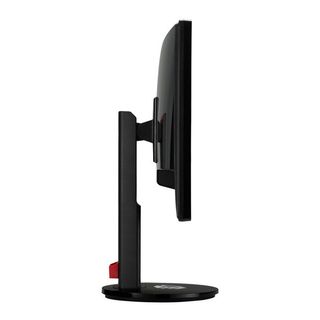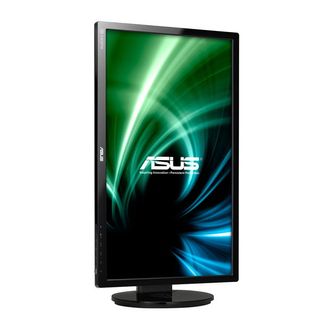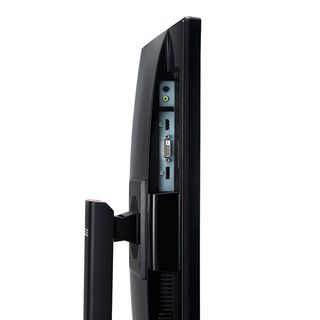Asus VG248QE: A 24-Inch, 144 Hz Gaming Monitor Under $300
Every performance-oriented gaming rig needs a speedy display to keep up with cutting-edge GPUs. Asus delivers up to 144 Hz with its VG248QE 24-inch TN-based monitor. Is its display performance as impressive as the company's sub-$300 price tag?
Packaging, Physical Layout, And Accessories
While most monitors come in a suitcase-style box that keeps the screen upright, the VG248QE is laid down in a more traditionally-shaped carton. It’s very large, affording a lot of room for protective foam. Included cables are DisplayPort, dual-link DVI, stereo audio (1/8" mini-plug), and an IEC power cord.
The only assembly required is screwing on the round base with the integrated wingnut. Also in the box is a CD with a user's manual, drivers, and ICC profiles. The software package includes Nvidia 3D Vision support. To complete that package, you’ll need an appropriate Nvidia graphics card and the company's 3D Vision kit with glasses and an emitter.
VG248QE: A Product 360

The VG248QE has every possible position adjustment: four inches of height, 15 degrees of tilt, 90 degrees of swivel, and rotation to portrait mode. All the movements feel nicely balanced without excess play. And the panel stays where you put it. If you want to use your own bracket, four screws release the upright to reveal a 100 mm VESA mount. The upright also has a small cable management clip in back to keep things tidy. The clip and the top of the upright are finished in bright red, which makes for a racy little accent.
Otherwise, the monitor’s styling is fairly ordinary. The plastic has a glossy finish that falls a bit shy of piano black. The screen has an effective anti-glare layer that does a good job of rejecting light, without creating image artifacts like grain or clarity reduction.
The bezel is 17 mm wide on the top and sides, and 20 mm wide on the bottom. The bulge on the panel’s back isn’t too big. In fact, it's actually nicely tapered from side to side. The control buttons are found on the bottom-right, facing down. They have a high-quality feel when you click them, putting up just the right amount of resistance. Labels printed on the front convey their functions. The first one is a hotkey that cycles through the six Splendid modes. Next, for menu navigation, is the minus/down button. This one is also a hotkey for GamePlus (more on that below). Third is menu, fourth is both plus/up and the brightness hotkey. Fifth is the input selector. And last is the power toggle.

Pressing the GamePlus hotkey pops up a little menu with a couple of unique options. With this feature, you can put a hardware-generated aiming point in the screen center (there are four reticules), or display a countdown timer for use in real-time strategy games. You can’t have both at the same time, though. The timer can be placed on the top, middle, or bottom of the screen’s left side. The available presets are 30, 40, 50, 60, or 90 minutes. Pressing the first control key turns the feature off.

Subtle though it may be, you can see the red trim we’re talking about. It’s just a cable keeper, but it does make for a nice bit of bling in an otherwise industrial design. There's even a little more red on top of the upright that isn't visible in the photo. The base is two parts, similar to a lazy Susan. That way you can swivel the panel 45 degrees in either direction without anything rubbing on your desktop. Vents across the top are just for cooling; the speakers are actually on the lower half of the panel, just under the VESA mount.
Stay on the Cutting Edge
Join the experts who read Tom's Hardware for the inside track on enthusiast PC tech news — and have for over 25 years. We'll send breaking news and in-depth reviews of CPUs, GPUs, AI, maker hardware and more straight to your inbox.

Of course, there is a portrait mode that's just about ideal for word processing on a 24-inch monitor. It’s a little less convenient for Web browsing though, because most websites are formatted at 1200 pixels wide, while this monitor is only 1080. The best use would probably be in conjunction with another 24- or 27-inch screen in its landscape orientation.

Inputs face downwards and include one DVI, DisplayPort, and HDMI connector. There is no VGA input and there are no USB ports. If you plan to game or watch in stereo, you’ll have to use the DVI connection with a dual-link cable and an Nvidia 3D Vision kit. For audio, there’s a stereo mini-jack (3.5 mm) and a headphone output. In the shot above, you can see the stereo speakers contained in a small housing just below the inputs. They are vented to the sides and rear. Their small size limits frequency response to the upper-mid-range. We wouldn’t call them tinny by any means, but their soundstage is pretty narrow. Aside from a separate desktop sound system, your best option for audio is going to come from a good pair of headphones.
Current page: Packaging, Physical Layout, And Accessories
Prev Page Asus VG248QE At 144 Hz, For The Speed-Obsessed Next Page OSD Setup And Calibration
Christian Eberle is a Contributing Editor for Tom's Hardware US. He's a veteran reviewer of A/V equipment, specializing in monitors. Christian began his obsession with tech when he built his first PC in 1991, a 286 running DOS 3.0 at a blazing 12MHz. In 2006, he undertook training from the Imaging Science Foundation in video calibration and testing and thus started a passion for precise imaging that persists to this day. He is also a professional musician with a degree from the New England Conservatory as a classical bassoonist which he used to good effect as a performer with the West Point Army Band from 1987 to 2013. He enjoys watching movies and listening to high-end audio in his custom-built home theater and can be seen riding trails near his home on a race-ready ICE VTX recumbent trike. Christian enjoys the endless summer in Florida where he lives with his wife and Chihuahua and plays with orchestras around the state.
-
ff6shadow I own this. Bought when it was first available. Great monitor for gaming. I use 2x GTX Titans with it.Reply -
SWEETMUSK if I have $300 dollars I will not buy for 24 inch "TN" screenReply
IPS is much better then TN -
Axonn People who think 144 Hz is more important than an 8-bit panel are in for a big, big fail.Reply -
ryude This monitor uses PWM (Pulse Width Modulation) for the backlight, which causing flickering. The only 144hz monitor that does not use PWM is the BenQ XL2420TE.Reply -
Plusthinking Iq they only sell BenQ XL2420T version in my country, so i bought the asus for the double pwm hz. pwm, the scourge og the lcd monitor.Reply -
CraigN ryude - yes, it uses PWM, however, as an owner of one of these monitors, I have not noticed any flickering at all. It's a really solid performing monitor. That same PWM comes in real handy when running in Lightboost mode for even more reductions to input lag.Reply
CaptainTom, 1ms makes a huge difference over 5ms. I didn't think it would at first until I bought one of these. Next to my old 24" HDTV that was my monitor for awhile, the difference is insane.
-
CraigN PS , Christian, your SmartBuy award photo at the end of the article is the wrong ASUS monitor ;) Also, would you guys mind releasing the ICC profile you guys calibrated for your tests?Reply
Most Popular


